When it comes to eco-friendly and inexpensive household cleaners, white vinegar is one of the best.
It can cut through soap scum, remove limescale, get rid of odours, and even tackle mild cases of mould. And since it’s non-toxic, you can use it around pets or small children!
Why buy dozens of products for home maintenance when one will do the trick? Put that pantry staple to work — here are some of our favourite ways to clean with vinegar.
What Type of Vinegar | Before Cleaning | Vinegar Uses for Cleaning | Removing Stains | Removing Mould | What Not to Clean
Is Vinegar Good for Cleaning?
Yes — but not for everything!
Vinegar is a versatile, natural cleaner, but like other solutions, it won’t work for every task.
As a weak acid, vinegar is most effective at tackling:
- Soap scum
- Hard water stains
- Unpleasant odours
- Limescale or mineral deposits
- Mild cases of mould or mildew
Lots of people prefer using vinegar since it’s natural and non-toxic, so it’s safe to use even around pets and small children. It’s also milder than store-bought cleaners.
Diluted white vinegar is also typically greywater safe.
What Type of Vinegar to Use for Cleaning?
For cleaning, it’s best to use either white distilled vinegar or cleaning vinegar.
Distilled white vinegar is what you can find in the condiment aisle at the supermarket. It has 4–7% acetic acid (typically 5%) and no colouring agents.
Cleaning vinegar is not the same as white vinegar. It has a higher concentration, usually at least 6%, and is not formulated for eating.
Both work well, but white vinegar is more commonly available.
What to Know Before Cleaning With Vinegar
Don’t grab the vinegar and start spraying just yet! While vinegar is generally safe to use, here are a few good things to know before cleaning.
What is the ratio of vinegar to water for cleaning?
You’ll need to dilute vinegar to make it safe for cleaning! For most surfaces, you can use a solution of equal parts vinegar and water.
Certain surfaces may be different, though. When cleaning floors — such as laminate and vinyl — use 1/2 cup per 3 litres of water.
Bathroom surfaces like showers, toilets, and tubs are more forgiving and can tolerate straight vinegar.
Are vinegar and baking soda effective for cleaning?
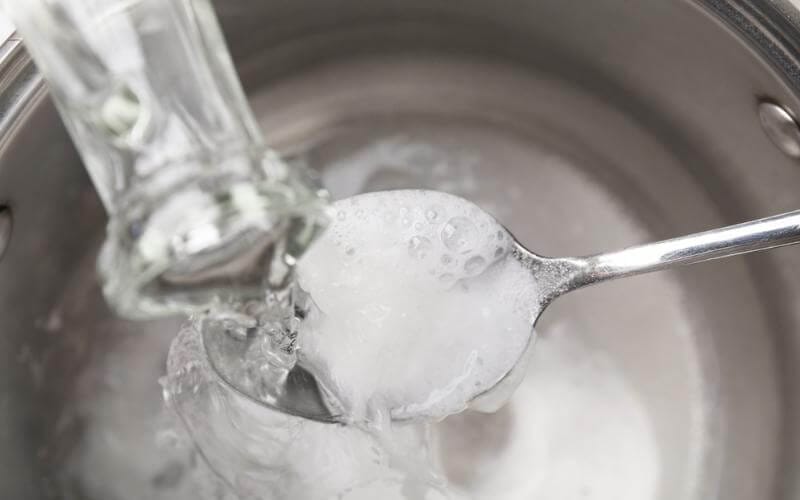
Despite popular advice, vinegar and baking soda are not effective when combined for cleaning.
Baking soda has a high pH (about 8.1–8.3), while vinegar has a low pH (2.4–2.7). When mixed, they neutralise each other, leaving you with some carbon dioxide, salt, and water.
You can use them to clean separately, though! Additionally, vinegar can help remove stubborn traces of baking soda on a surface.
What happens when you mix vinegar and dish soap?
Mixing a small amount of dish soap with vinegar creates a versatile cleaning solution, but only a little!
Don’t add more than a few drops per cup of vinegar, or you’ll reduce the effectiveness of both cleaners.
What should I not mix with vinegar when cleaning?
Never mix white vinegar with bleach, ammonia, hydrogen peroxide, and other chemical cleaners.
The vinegar can react with these products to create toxic gases that are very dangerous to your health.
How to Clean with Vinegar Around Your Home
White vinegar can clean a lot of surfaces in your home — in the kitchen, bedroom, bathroom, you name it.
We asked some of our professional cleaners for their favourite vinegar cleaning hacks!
Beds
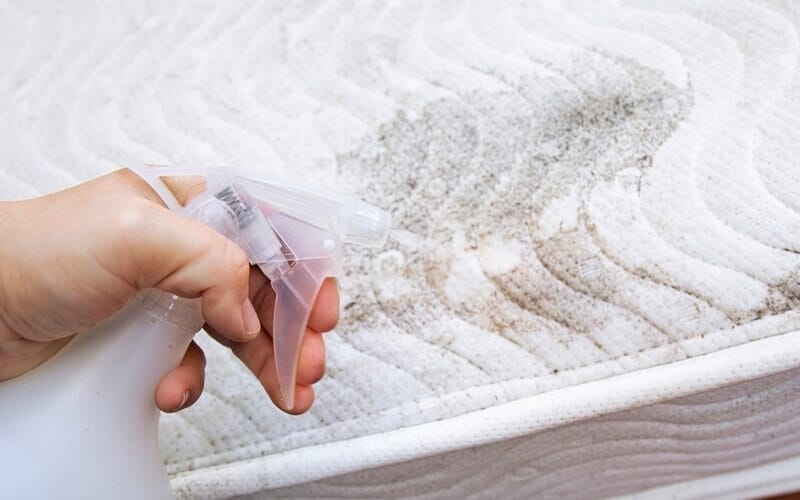
Mix equal parts water and vinegar in a spray bottle to clean different types of mattresses, including hybrid, latex, and spring mattresses.
You can also tackle different mattress stains with vinegar. It’s most effective at removing sweat marks or neutralising urine stains and odours in a mattress.
Vinegar also works to remove stains from pillows.
Leave the mattress or pillow to air dry for at least half a day so the scent dissipates.
Benchtops and cabinets
Dirty kitchen cabinets can make the room look messier than it is!
Clean high-gloss kitchen cabinets with a mix of 1 part vinegar to 2 parts warm water (a little dish soap is optional). Dip a soft cloth in the solution, then wipe the cabinet doors and other surfaces clean.
The same solution can clean your laminate cabinets without leaving streaks.
Just follow with a cloth dampened in clean water to rinse off the residue, then dry the cabinets ASAP!
Faucets and showerheads
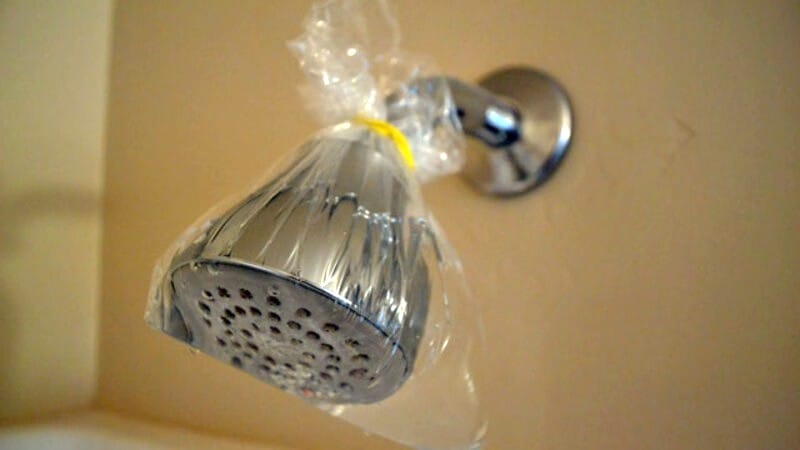
Vinegar is very effective at removing soap scum and mineral deposits. It’s best used on plastic and chrome fixtures, as it can etch brass, bronze, copper, and nickel.
To refresh the showerhead, pour vinegar in a plastic bag and tie it around the fixture (or fix it with a rubber band). Wait 30–60 minutes, then remove the bag and scrub the fixture clean with an old toothbrush.
You can also use a vinegar solution to clean the shower hose.
For faucets, scrub them with a paste of vinegar and salt. If they’re not too dirty, though, dampen a soft cloth with some vinegar and wipe clean.
Floors
White vinegar is an inexpensive cleaner for several types of flooring — namely laminate, porcelain or ceramic tile, and vinyl.
When mopping tile floors, mix half a cup of vinegar per litre of water. Dip a mop into the solution and wring it out, then carefully wash the floor.
If you want to make a DIY grout cleaner, add a few drops of dishwashing liquid to the vinegar solution and spray it onto the grout lines. Let it sit for up to 10 minutes before scrubbing the grout clean.
For cleaning laminate floors or vinyl flooring, you’ll need to dilute the vinegar a bit more — about 1 cup per 3 litres of warm water. Always make sure the mop is just damp, so you’re not using too much moisture.
Dry the floors immediately afterwards for a streak-free finish.
Kettles
A clean kettle is an essential part of a good brew, and vinegar helps remove calcium deposits (called descaling) and other dirt.
You can clean the exterior of most kettles with equal parts water and vinegar. Dampen a cloth in the solution and wipe the kettle clean.
To descale a kettle, pour a half-and-half mix of vinegar and water into the kettle so it’s halfway full. Bring the solution to a boil, then take it off the heat and let the solution sit for up to 20 minutes.
Scrub the kettle clean, then rinse and dry.
Laundry
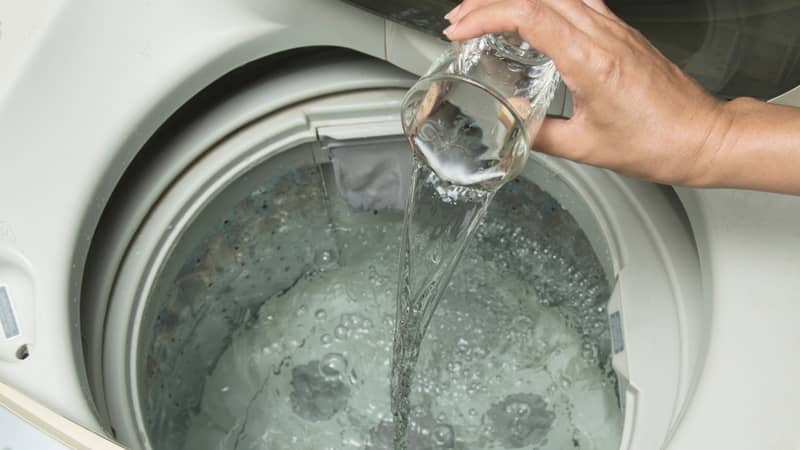
Skip the fabric softener and use vinegar in the rinse cycle of your washing machine to remove odours and soften fabrics.
Keep a few things in mind, though! First, you shouldn’t do this all the time, especially if you have a front-load washer. Repeated, prolonged exposure to vinegar can damage the gaskets or hoses.
Second, do not use vinegar if you have a peroxide- or bleach-based detergent. And lastly, avoid using it for delicate fabrics like silk.
Adding vinegar to laundry is straightforward — pour 1/4 to half a cup of vinegar into the rinse cycle! Pause your washer to add it into the tub, or see if you can add it into the rinse aid compartment.
If needed, run another rinse cycle to remove any lingering vinegar.
FYI: Check your washer’s manual first! Some brands prohibit the use of vinegar no matter what, and it could void your warranty.
Microwaves
Easily steam clean your microwave with white vinegar!
Add about 2 tbsp of vinegar to a cup of water in a microwave-safe container. Place it inside, then run the microwave on high for 2–4 minutes, or until the mixture starts to boil and steam up the inside.
Wipe the inside of the microwave with a soft cloth, then dry. Do this once a week to prevent a buildup of dirt and grime.
Refrigerators
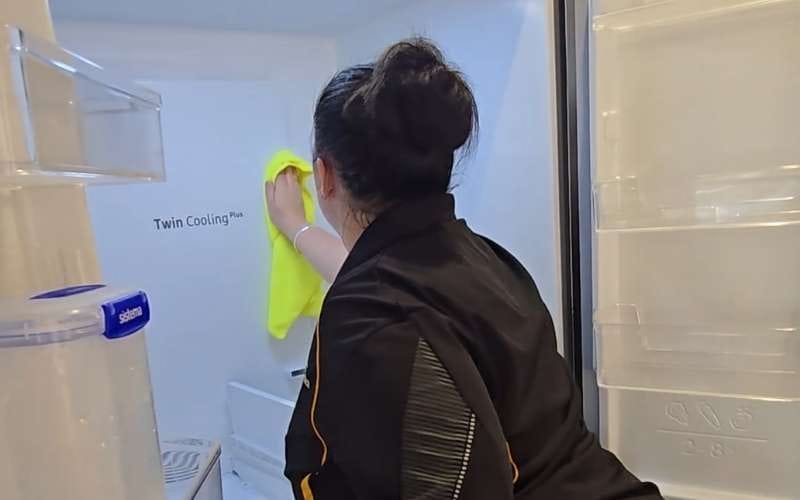
Your fridge should be deep-cleaned every 3–4 months to keep it in good condition. A mess inside the fridge could lead to spoilage or even mould, while dirt can prevent it from keeping your food cool.
Mix equal parts water and vinegar in a spray bottle, then saturate the empty interior of the fridge. Wait a few minutes before wiping the surfaces clean with a microfibre cloth.
The same solution also works to clean a smelly fridge, since vinegar helps neutralise odours.
Finally, use it to flush out and clean your fridge’s water dispenser every 3–6 months.
Showers and tubs
Soap scum and mineral deposits accumulate easily in the shower, and vinegar is great for getting rid of that buildup. It can also clean off any mildew in the bathroom area.
To wash the shower glass, generously spray the surfaces with a 1:1 mix of vinegar and water. Wait 10 minutes, then wipe the glass surfaces clean with a soft cloth.
The same goes for cleaning a bathtub, except for iron or stone tubs.
For more stubborn stains — such as extra-tough limescale — opt for undiluted vinegar. Heat it on the stove, then use the warm vinegar to clean the shower or tub.
Don’t forget to wear rubber gloves while working!
Sinks and drains
It’s best to wash your kitchen sink at the end of each day, then deep clean the sink and drain once a week. This helps keep the area safe and hygienic.
For ceramic or porcelain sinks, mix a half-and-half solution of vinegar and water, plus a few drops of mild dish soap. Dip a sponge in the mixture and thoroughly scrub the sink.
Don’t forget the faucets and handles, too!
For sink drains, boil equal parts water and vinegar in a kettle, then carefully pour it down the drain. Wait a few minutes, then wash the drain area with soap and water before running the faucet for 30 seconds to rinse.
Stainless steel
Vinegar is a good homemade cleaner for stainless steel, with some caveats.
Always use diluted white vinegar to lessen the risk of pitting or damage. Moreover, don’t let the vinegar sit on a surface for too long so it doesn’t etch the finish.
Spot-clean stainless steel surfaces and appliances with a mix of 3 parts water plus 1 part vinegar in a spray bottle. Wipe the surfaces clean with a damp cloth, going with the grain.
Windows
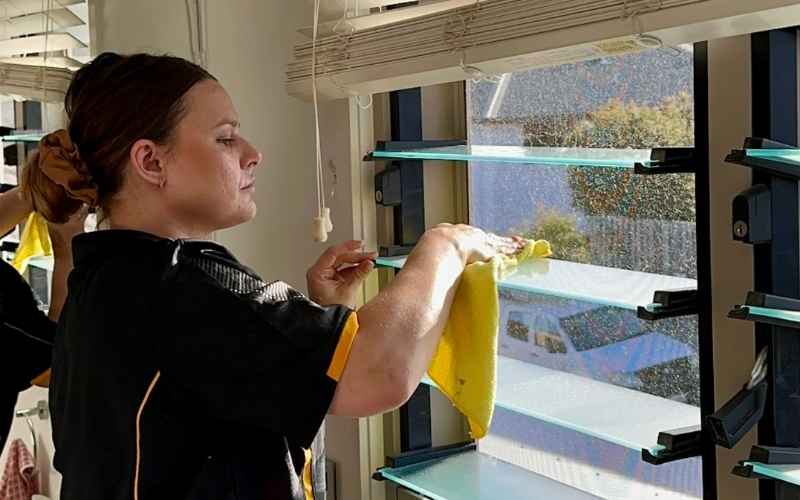
Make a DIY window cleaner with vinegar for sparkling, streak-free glass!
To wash your windows, mix equal parts vinegar and water in a spray bottle (a tiny bit of dish detergent is optional). Generously apply it to the glass, then work it into the surface with a microfibre cloth.
The same solution will clean a mirror, too.
PRO TIP: If you’re cleaning both sides of the window, wipe one side horizontally and the other side vertically! That way, if you notice streaks, you’ll know which side they’re on.
Removing Stains with White Vinegar
Distilled white vinegar is great for tackling household stains, from bedsheets to your toilet bowl.
As a multi-purpose stain remover, use a mix of equal parts water and vinegar. Test the solution on a small spot first to make sure it won’t damage the surface.
Here are a couple of hacks for removing stains with vinegar:
- Red wine or coffee on carpet: Blot the area with a cloth dampened with diluted vinegar
- Sweat stains on bedsheets: Pre-treat with a mix of 2 tbsp vinegar in 2 cups of water
- Toilet bowl stains: Pour a few cups of vinegar into the toilet and leave for a few hours
- Yellowed bedsheets: Pre-soak the sheets in a mix of 1/2 cup vinegar per 4 litres of water
Can Vinegar Get Rid of Mould?
Yes, vinegar can kill mould, but it takes time and it won’t work on all surfaces.
Vinegar should have at least a 4.2% acetic acid concentration to kill mould or mildew. Distilled white vinegar is around 5%, so it can work, but it needs at least an hour of contact on the surface.
You can use vinegar to remove mould on most non-porous surfaces, and clothing if the case is mild.
Wear rubber gloves, an N95 (or KN95) face mask, and eye protection while cleaning mould or mildew. Make sure you work in a well-ventilated space.
Saturate the surface with undiluted vinegar and allow it to sit for at least an hour (or even overnight). Afterwards, scrub the area clean with a sponge or scrub brush.
Avoid using vinegar on surfaces such as:
- Wood
- Natural stone
- Upholstered furniture
- Porous surfaces like carpets
- Metals like aluminium, copper, and iron
If the mould is on upholstered furniture or covers an area larger than 0.9sqm, it’s best to contact a professional mould remediation company.
Is There Anything You Shouldn’t Clean With Vinegar?

White vinegar is versatile, but it can’t clean everything! There are certain surfaces or items where it can do more harm than good.
Anything that needs disinfecting
Vinegar has mild disinfecting properties, but it’s less effective at killing bacteria than using 3% hydrogen peroxide or 70% rubbing alcohol.
You’re better off using hydrogen peroxide, rubbing alcohol, or other commercial sanitisers to be safe. Don’t mix products, though!
Cast iron and aluminium
You can clean aluminium surfaces with vinegar, but it’s not our recommended option since prolonged exposure can cause pitting, etching, or other types of damage to the finish.
If you must use it, dilute it with an equal amount of water first.
For iron (such as cast iron pans), follow the manufacturer’s recommendations.
Dishwashers
Adding vinegar to a rinse cycle or using it for routine cleaning isn’t bad if you only do it once in a while. But repeated and prolonged exposure to vinegar can dry out the seals and degrade the material.
When cleaning your dishwasher, it’s better to use a dedicated product like Finish Dishwasher Cleaner, or check if your model has a cleaning cycle.
Natural stone
The acid in vinegar can etch and discolour natural stone! A small amount won’t hurt, especially if wiped immediately, but prolonged exposure can damage the finish.
If you’re cleaning stone benchtops, stick to warm water and mild dish soap. Hydrogen peroxide also works on light-coloured stone surfaces like benchtops and tiles.
When cleaning stone tiles, use pH-neutral products or dedicated stone cleaners.
Oil and grease
Soap, baking soda, or even commercial degreaser are more effective at tackling stains from oil and grease.
For fresh stains, they can usually be washed off with soap and water — or, for a stronger solution, try Dawn Powerwash.
For dried stains, use a thick paste of baking soda and water. Let it sit on the surface for at least 5 minutes, then gently scrub off the stain with a damp cloth.
Unsealed grout
You can clean sealed grout with vinegar, but unsealed or damaged grout is trickier. Prolonged exposure can degrade the cement-based material.
Your best bet for cleaning unsealed grout is using baking soda, soap, or hydrogen peroxide (for light grout).
If you prefer to use vinegar, do not let it sit for more than 30 minutes. Rinse the surface thoroughly afterwards, then dry the grout.
Wood surfaces
Whether it’s hardwood floors or wood furniture, avoid using vinegar — even diluted! The acid can etch wood and damage the coating.
Stick to dedicated wood cleaners when washing hardwood floors, or damp mop with a pH-neutral soap and water. For furniture, follow the manufacturer’s recommendations for cleaning.
FAQs About Using White Vinegar for Cleaning
Here are a few more common concerns people have about cleaning with vinegar.
Is vinegar abrasive?
No, vinegar isn’t abrasive! It’s a liquid that can clean surfaces due to the acetic acid.
On the other hand, abrasive cleaners have scratchy surfaces or contain fine particles (such as powders) that physically remove dirt with scrubbing. Powder cleansers and scrubbing pads are considered abrasive.
Does vinegar need to be rinsed off?
Not always! For vinegar mixed with water, most of the time you can wipe the surface dry with a soft cloth.
However, if you’ve mixed the vinegar with something (like dish detergent), it’s best to rinse so you don’t leave streaks or residue. Wipe off the cleaning solution with a damp microfibre cloth.
How to avoid the smell when using vinegar to clean?
If the smell of vinegar puts you off when cleaning, try masking it with an essential oil!
Some popular options include:
- Lavender oil
- Lemon oil
- Orange oil
- Tea tree oil
Add just a few drops per 2 cups of vinegar (or diluted vinegar solution). It won’t erase the scent entirely, but it can make it more pleasant.
You can also warm vinegar with some lemon peels (or any other citrus peel), which will help the scent and add a tiny cleaning boost.
However, the vinegar smell should dissipate within the day, whether you add something or not.

